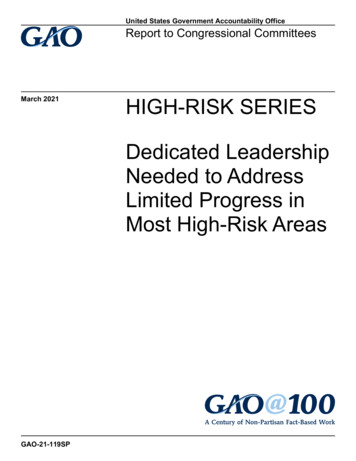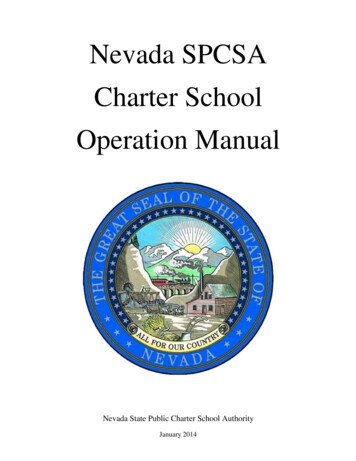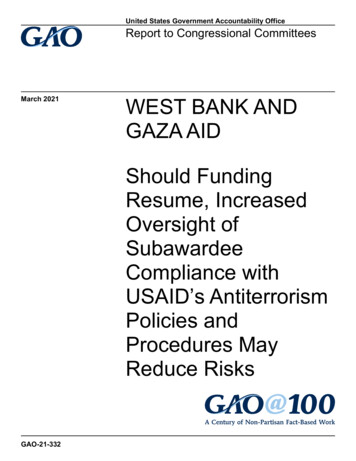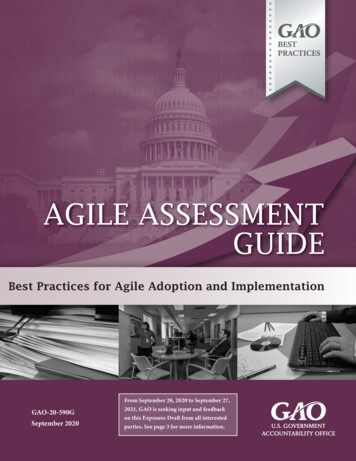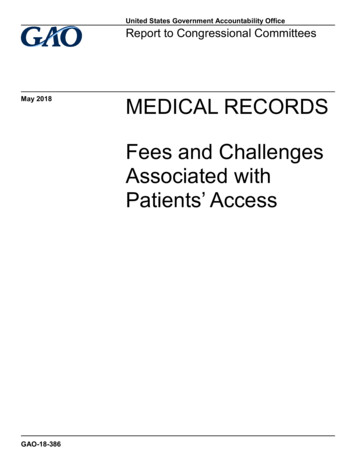
Transcription
United States Government Accountability OfficeReport to Congressional CommitteesMay 2018MEDICAL RECORDSFees and ChallengesAssociated withPatients’ AccessGAO-18-386
May 2018MEDICAL RECORDSFees and Challenges Associated with Patients’AccessHighlights of GAO-18-386, a report tocongressional committeesWhy GAO Did This StudyWhat GAO FoundHIPAA and its implementingregulations, as amended by the HealthInformation Technology for Economicand Clinical Health Act, require healthcare providers to give patients, uponrequest, access to their medicalrecords, which contain protected healthinformation (i.e., diagnoses, billinginformation, medications, and testresults). This right of access allowspatients to obtain their records or havethem forwarded to a person or entity oftheir choice—such as anotherprovider—in a timely manner whilebeing charged a reasonable, costbased fee. Third parties, such as alawyer or someone processingdisability claims, may also requestcopies of a patient’s medical recordswith permission from the patient.Available information suggests that the fees charged for accessing medicalrecords can vary depending on the type of request and the state in which therequest is made. Under the Health Insurance Portability and Accountability Act of1996 (HIPAA) and its implementing regulations, providers are authorized tocharge a reasonable, cost-based fee when patients request copies of theirmedical records or request that their records be forwarded to another provider orentity. In the case of third-party requests, when a patient gives permission foranother entity—for example, an attorney—to request copies of the patient’smedical records, the fees are not subject to the reasonable cost-based standardand are generally governed by state law. According to stakeholders GAOinterviewed, the fees for third-party requests are generally higher than the feescharged to patients and can vary significantly across states.The 21st Century Cures Act included aprovision for GAO to study patientaccess to medical records. Amongother things, this report describes (1)what is known about the fees foraccessing patients’ medical recordsand (2) challenges identified bypatients and providers when patientsrequest access to their medicalrecords. GAO reviewed selectedHIPAA requirements and implementingregulations and guidance, and relevantlaws in four states selected in partbecause they established a range offees associated with obtaining copiesof medical records. GAO alsointerviewed four provider associations,seven vendors that work for providers,six patient advocates, state officials,and Department of Health and HumanServices’ (HHS) officials. Theinformation GAO obtained and itsanalysis of laws in the selected statesare not generalizable. HHS providedtechnical comments on this report.View GAO-18-386. For more information,contact Carolyn L. Yocom at (202) 512-7114or yocomc@gao.gov.The four states GAO reviewed have state laws that vary in terms of the feesallowed for patient and third-party requests for medical records. For example,three of the states have per-page fee amounts for patient and third-party recordsrequests. The amounts charged are based on the number of pages requestedand vary across the three states. One of the three states has established a different per-page fee amount forthird-party requests. The other two do not authorize a different fee for patientand third-party requests.One of the three states also specifies a maximum allowable fee if theprovider uses an electronic health records system. The other two do notdifferentiate costs for electronic or paper records.In the fourth state, state law entitles individuals to one free copy of their medicalrecord. The statute allows a charge of up to 1 per page for additional copies.Patient advocates, provider associations, and other stakeholders GAOinterviewed identified challenges that patients and providers face when patientsrequest access to their medical records. Patients’ challenges include incurring what they believe to be high fees whenrequesting medical records—for example, when facing severe medicalissues that have generated a high number of medical records. Additionally,not all patients are aware that they have a right to challenge providers whodeny them access to their medical records.Providers’ challenges include the costs of responding to patient requests forrecords due to the allocation of staff time and other resources. In addition,according to provider associations and others GAO interviewed, fulfillingrequests for medical records has become more complex and challenging forproviders, in part because providers may store this information in multipleelectronic record systems or in a mix of paper and electronic records.United States Government Accountability Office
ContentsLetter1BackgroundAvailable Information Suggests That Fees for Accessing PatientMedical Records Vary by Type of Request and StateStakeholders Identified Fees and Other Challenges for PatientsAccessing Medical Records and Challenges for Providers inAllocating Resources to Respond to RequestsOCR Investigates Complaints, Audits Providers, and EducatesPatients and Providers about Patient AccessAgency CommentsAppendix IGAO Contact and Staff Acknowledgments4813182324TablesTable 1: Health Insurance Portability and Accountability ActAccess Guidance Options for Calculating Reasonable,Cost-Based Fees for Patient and Patient-DirectedRequestsTable 2: Allowable Fees for Requests for Medical Records inSelected States911FiguresFigure 1: Provider and Vendor Process for Fulfilling MedicalRecord RequestsFigure 2: HHS Office for Civil Rights Time to Close ComplaintsReceived between February 2016 and June 2017Page i720GAO-18-386 Patient Access to Medical Records
AbbreviationsEHRHHSHIPAAHITECH ActOCROIGONCROIelectronic health recordDepartment of Health and Human ServicesHealth Insurance Portability and Accountability Actof 1996Health Information Technology for Economic andClinical Health ActOffice for Civil RightsOffice of Inspector GeneralOffice of the National Coordinator for HealthInformation Technologyrelease-of-informationThis is a work of the U.S. government and is not subject to copyright protection in theUnited States. The published product may be reproduced and distributed in its entiretywithout further permission from GAO. However, because this work may containcopyrighted images or other material, permission from the copyright holder may benecessary if you wish to reproduce this material separately.Page iiGAO-18-386 Patient Access to Medical Records
Letter441 G St. N.W.Washington, DC 20548May 14, 2018The Honorable Lamar AlexanderChairmanThe Honorable Patty MurrayRanking MemberCommittee on Health, Education, Labor, and PensionsUnited States SenateThe Honorable Greg WaldenChairmanThe Honorable Frank Pallone Jr.Ranking MemberCommittee on Energy and CommerceHouse of RepresentativesIn the course of seeking or obtaining health care, patients may requestand obtain their medical records. They may, for example, want to taketheir medical records to another health care provider, or use the recordsto apply for disability coverage or resolve a dispute over insurancecoverage. 1 Patients may obtain their records directly in an electronic orpaper form or direct one provider to send these records to anotherprovider or entity, such as an insurer or lawyer. In other cases, a thirdparty, such as a lawyer or someone processing disability claims, maydirectly contact a provider to request access to a patient’s medicalrecords with permission from the patient.The Health Insurance Portability and Accountability Act of 1996 (HIPAA),as amended, and its implementing regulations, require HIPAA-coveredentities (e.g., providers and insurers) to provide individuals, upon request,with access to their medical records, which contain protected healthinformation (e.g., information on diagnoses, billing, medications, and testresults). 2 This right of access allows patients to obtain their medicalrecords in a timely manner while being charged a reasonable, cost-based1For the purposes of this report, we use the term “provider” to refer to physicians,hospitals, and other health care practitioners.2The Health Information Technology for Economic and Clinical Health (HITECH) Actamended HIPAA and its implementing regulations. As relevant here, the HITECH Actspecified requirements in the application of the patient access regulation. Pub. L. No. 1115, § 13405(e), 123 Stat. 115, 268 (2009).Page 1GAO-18-386 Patient Access to Medical Records
fee. Federal law also states that an individual can direct a provider tosend the records to a person of the individual’s choice. 3 In 2016, theDepartment of Health and Human Services’ (HHS) Office for Civil Rights(OCR), which is responsible for enforcing the rights established underHIPAA, issued guidance about the right of access. Among other things,the guidance states that when a patient requests that his or her medicalrecords be forwarded to a person or entity, a reasonable, cost-based feecan be charged.The 21st Century Cures Act included a provision for us to study patientaccess to medical records and issue a report by June 13, 2018. 4 In thisreport we describe1. what is known about the fees charged for accessing patients’ medicalrecords,2. challenges identified by patients and providers when patients requestaccess to their medical records, and3. efforts by OCR to ensure patients’ access to their medical records.To describe what is known about the fees charged for accessing patients’medical records, we reviewed selected HIPAA requirements andimplementing regulations and guidance. We conducted interviews withrelevant stakeholders, including representatives from seven release-ofinformation (ROI) vendors and nine individuals or entities with expertise inHIPAA, including HIPAA lawyers in both private practice and who work inhealth policy. 5 We selected these stakeholders based on our initialbackground research, prior work, and input from other stakeholders.During our interviews, we asked about examples of state laws that governthe fees for obtaining copies of medical records. Using this information,we judgmentally selected four states for closer review—Kentucky, Ohio,Rhode Island, and Wisconsin. We selected these states based on input3Given that this report is about patient access to medical records, in some instances weuse the term “patient” to refer to an individual with regard to his or her HIPAA accessrights and “provider” to refer to providers who are the relevant HIPAA-covered entities.The Privacy Rule defines “covered entity” as a health plan, a health care clearinghouse,and a health care provider who transmits any health information in electronic form inconnection with a transaction covered by the regulations. 45 C.F.R. § 160.103 (2017).4Pub. L. No. 114-255, § 4008, 130 Stat. 1033, 1184-1185 (2016).5ROI vendors gather and release medical records on behalf of providers.Page 2GAO-18-386 Patient Access to Medical Records
from stakeholders, a review of state laws, and because these states havea range of different types of fees. In Ohio, Rhode Island, and Wisconsin,we interviewed officials in the state agencies responsible for oversight ofpatients’ access to medical records. Officials from Kentucky declined aninterview but provided written responses to our questions. Theinformation we obtained from stakeholders and our analysis of laws in theselected states are not generalizable.To describe challenges identified by patients and providers when patientsrequest access to their medical records, we interviewed relevantstakeholders. Specifically, we interviewed individuals or entities withexpertise in the topic of patients’ access to health information (referred tohereafter as experts), six patient advocates, representatives from fourorganizations that represent providers (provider representatives), andrepresentatives from seven ROI vendor companies. We judgmentallyselected these stakeholders based on our previous studies, presentationsat conferences, relevant testimony at Congressional hearings, andrecommendations by other interviewees. We also interviewed officialsfrom HHS’s OCR, Office of the National Coordinator for HealthInformation Technology (ONC), and Office of Inspector General (OIG).We obtained specific examples of situations when patients have facedchallenges accessing their medical records; these examples wereprovided to us by OCR and an organization that collects anecdotes frompatients about their experiences. The information we obtained fromstakeholders is not generalizable.To describe efforts by OCR to ensure patients’ access to their medicalrecords, we reviewed data from OCR on all patient access complaintsreceived between February 2016 and June 2017. We assessed thereliability of these data by (1) performing electronic testing of requireddata elements, (2) reviewing existing information about the data and thesystem that produced them, and (3) consulting agency officials who areknowledgeable about the data. We determined that these data weresufficiently reliable for the purposes of our reporting objectives. We alsoreviewed relevant OCR documentation, including policies andprocedures, audit guidelines, and reports on HIPAA violations, as well as10 examples of patient access complaints provided to us by OCR. Finally,we interviewed officials from OCR and ONC.We conducted this performance audit from March 2017 to May 2018 inaccordance with generally accepted government auditing standards.Those standards require that we plan and perform the audit to obtainsufficient, appropriate evidence to provide a reasonable basis for ourPage 3GAO-18-386 Patient Access to Medical Records
findings and conclusions based on our audit objectives. We believe thatthe evidence obtained provides a reasonable basis for our findings andconclusions based on our audit objectives.BackgroundMedical Record RequestsHIPAAPatients may request copies of their medical records, or request thatcopies of their records be sent to a designated person or entity of theirchoice. In a patient request, a patient or former patient requests access to orcopies of some or all of her medical records, in either paper orelectronic format. For example, a patient might want to keep copiesfor her own personal use or to bring with her when moving orchanging providers. In a patient-directed request, a patient or former patient requeststhat a provider or other covered entity send a copy of the patient’smedical records directly to another person or entity, such as anotherprovider. For example, a patient might request that her medicalrecords be forwarded to another provider because the patient ismoving or wants to seek a second opinion. In a third-party request, a third party, such as an attorney, obtainspermission from a patient (via a HIPAA authorization form that issigned by the patient) to access the patient’s medical records. Forexample, with permission from the patient, a lawyer might requestcopies of a patient’s medical records to pursue a malpractice case. 6HIPAA’s Privacy Rule—the regulations that implement HIPAA’s privacyprotections—requires that upon request, HIPAA-covered entities, such ashealth care providers and health plans, provide individuals with access to6A patient’s records may be released by means of a patient-directed request or a thirdparty request. A key difference between patient, patient-directed, and third-party requestsis that in the case of the two types of patient requests, a provider is required to disclosethe record, except when an exception applies. In contrast, in a third-party request with avalid HIPAA authorization, the provider is permitted (but not required) to disclose therecord.Page 4GAO-18-386 Patient Access to Medical Records
their medical records. 7 Under HIPAA’s implementing regulations,providers and other covered entities must respond to a patient or patientdirected request for medical records within 30 days. The Privacy Rulealso establishes an individual’s right to inspect or obtain a copy of his orher medical records which, as amended in 2013, includes the right todirect a covered entity to transmit a copy of the medical records to adesignated person or entity of the individual’s choice. 8 Individuals havethe right to access their medical records for as long as the information ismaintained by a covered entity or by a business associate on behalf of acovered entity, regardless of when the information was created; whetherthe information is maintained in paper or electronic systems onsite,remotely, or is archived; or where the information originated. Finally, theHIPAA Privacy Rule also describes the circumstances under whichprotected health information in medical records may be released topatients and third parties. 9In February 2016, OCR issued guidance to explain its 2013 regulations. 10Among other things, this guidance states that as part of a patient’s right ofaccess, patients have the right to obtain copies of their medical recordsand the right to have their records forwarded to a person or entity of their7See 45 C.F.R. pt. 164 (2017). Medical records contain protected health information thatis kept in designated record sets maintained by the covered entity. The designated recordset is defined at 45 CFR §164.501 as a group of records maintained by or for a coveredentity that comprises the medical records and billing records about individuals maintainedby or for a covered health care provider; enrollment, payment, claims adjudication, andcase or medical management record systems maintained by or for a health plan; or otherrecords that are used, in whole or in part, by or for the covered entity to make decisionsabout individuals.845 C.F.R. §§ 164.502(a)(1), 164.524(c)(3)(ii) (2017). In 2013, HHS issued a final rule toimplement statutory amendments to HIPAA made under the HITECH Act. See 78 Fed.Reg. 5566 (Jan. 25, 2013).9In addition to HIPAA’s Privacy Rule, there are several other HIPAA rules related toprotected health information and patient medical records. For example, the HIPAASecurity Rule establishes national standards to protect electronic health information andrequires certain safeguards to ensure the confidentiality, integrity, and availability of suchinformation (see 45 CFR Part 160 and Subparts A and C of Part 164). The HIPAA BreachNotification Rule requires covered entities to notify affected individuals and HHS followinga breach of unsecured protected health information (see 45 CFR Part 160 and Subparts Aand D of Part 164).10OCR’s guidance on individuals’ rights under HIPAA to access their health informationcan be found online. See Department of Health and Human Services, Individuals’ Rightunder HIPAA to Access Their Health Information 45 CFR § 164.524, accessed December21, rivacy/guidance/access/index.html.Page 5GAO-18-386 Patient Access to Medical Records
choice; in these circumstances, patients are only to be charged a“reasonable, cost-based fee.” 11 The guidance further notes that state lawsthat provide individuals with greater rights of access to their medicalrecords are not preempted by HIPAA and still apply. With respect to fees,patients may not be charged more than allowed under the Privacy Rule,even if state law provides for higher or different fees. 12Fulfilling Medical RecordRequestsTo respond to medical record requests, providers either use staff withintheir organization or may contract with ROI vendors to conduct this work.In general, both providers’ staff and ROI vendors follow the same processwhen fulfilling requests for medical records for both individual patientsand third parties. (See fig. 1.)1145 C.F.R. § 164.524(c)(4) (2017).12In general, state laws that are contrary to the HIPAA Privacy Rule are preempted byHIPAA unless a specific exception applies. One exception is if the state law providesgreater privacy rights (including patient access rights) with respect to such information.Page 6GAO-18-386 Patient Access to Medical Records
Figure 1: Provider and Vendor Process for Fulfilling Medical Record RequestsPage 7GAO-18-386 Patient Access to Medical Records
Available InformationSuggests That Feesfor Accessing PatientMedical Records Varyby Type of Requestand StateAvailable information suggests that the allowable fees for accessingmedical records vary by type of request—that is, whether a patient orthird party is making the request—and by state. Federal laws establishlimits on the fees that may be charged for two of the three types ofrequests for medical records: (1) patient requests, when patients requestaccess to their medical records, and (2) patient-directed requests, whenpatients request that their records be sent to another person or entity,such as another provider. HIPAA does not establish limits on fees forthird-party requests.For patient and patient-directed requests, providers may charge a“reasonable, cost-based fee” under HIPAA’s implementing regulations.OCR’s 2016 guidance gives examples of options providers (or a ROIvendor responding to requests for medical records on behalf of aprovider) may use in determining a “reasonable cost-based fee.” 13 (Seetable 1.)13On January 8, 2018, Ciox Health, LLC, a ROI vendor, filed suit against HHS regardingthe “reasonable, cost-based fee” applicable to patient-directed requests. Ciox Health, LLCv. Azar, No. 1:18-cv-0040 (D.D.C. filed Jan. 8, 2018). As of April 2018, no decision hadbeen rendered in this case.Page 8GAO-18-386 Patient Access to Medical Records
Table 1: Health Insurance Portability and Accountability Act Access Guidance Options for Calculating Reasonable, CostBased Fees for Patient and Patient-Directed RequestsMethod for calculatingportion of fee for laborcostsOption 1Actual costsOption 2Average costsOption 3Flat feeProvider calculates actual laborcosts to fulfill the request.Provider develops a scheduleof costs for labor based onaverage labor costs to fulfillstandard types of requests.A provider may charge individuals aflat fee for all requests for electroniccopies of protected healthinformation that is maintainedelectronically, provided the fee doesnot exceed 6.50.Types of labor/materials for Labor for copying (and creating awhich fee appliessummary or explanation if theindividual requests or agrees),applicable supplies (CD or USBdrive), and postage.Types of labor/materialsthat must be provided freeof chargeProviders may add to theCharge may not exceed 6.50 andaverage labor cost amount any is inclusive of all labor, supplies,applicable supply (e.g., paper, and postage.or CD or USB drive) or postagecosts.Review of access request; searching for, retrieving, and otherwise preparing the responsive informationfor copying; ensuring information relates to the correct individual; segregating, collecting, compiling, andotherwise preparing the response information for copying.Per page fees are not permitted for paper or electronic copies of protected health information maintainedelectronically.Source: Department of Health and Human Services’ Office for Civil Rights 2016 guidance. GAO-18-386In addition to the HIPAA requirements, some states have establishedtheir own fee schedules, formulas, or limits on the allowable fees forpatient and patient-directed requests. State laws that allow for higher feesthan permitted under HIPAA are preempted by the federal law, but thoseproviding for lower fees are not preempted. 14 Representatives from ROIvendors, provider representatives, and other stakeholders we interviewedtold us that not all states have established their own requirementsgoverning the fees for medical record requests and, among the statesthat have, the laws can vary. For example, states can vary as to whetherthey set a maximum fee that may be charged or whether they establish afee schedule that is applicable to paper records, electronic records, orboth. While states may establish per-page amounts that can be chargedfor a copy of a patient’s medical records, these per-page amounts canvary.14OCR’s 2016 access guidance does not establish a fee schedule and does not specify adollar amount that is to be charged for every request for records. Instead, it describesthree permissible methods of calculating the reasonable, cost-based fee permitted by theregulation.Page 9GAO-18-386 Patient Access to Medical Records
In contrast with patient and patient-directed requests, the fees for thirdparty requests are not limited by HIPAA’s reasonable, cost-basedstandard for access requests and are instead governed by state laws,regulations, or other requirements. For third-party requests, providers andvendors working on their behalf may charge whatever is allowed underthese state requirements. According to ROI vendors and otherstakeholders we interviewed, such fees are typically higher than thereasonable, cost-based fees permitted under HIPAA for patient andpatient-directed requests and may be established by formulas that varyby state. For example, states can vary as to whether they establish perpage copy fees, allow providers to charge a flat fee, or charge differentfees based on the type of media requested (e.g., electronic copies, Xrays, microfilm, paper, etc.). Additionally, state laws of generalapplicability (for example, the commercial code) may govern thepermissible fees applicable to ROI release of records. Representatives ofROI vendors we interviewed stated that there is significant variation in thestate laws that govern the fees for third-party requests, and companiesemploy staff to track the different frameworks.Across the four selected states, we found examples of the kinds ofvariation stakeholders have described in the allowable fees for patientand third-party requests for medical records. (See table 2.) Three of the states— Ohio, Rhode Island, and Wisconsin—haveestablished per-page fee amounts. The amounts charged are basedon the number of pages requested and vary across the three states.These three states have also established specific fee rates forrequesting media such as X-ray or magnetic resonance imaging scanimages. One state—Ohio—has established a different per-page fee amountfor third-party requests. The other three states have not establisheddifferent fees for different types of requests (i.e., between patient andthird-party requests). One state—Rhode Island—specifies a maximum allowable fee if theprovider uses an electronic health records (EHR) system for patientand patient-directed requests. One state—Kentucky—entitles individuals to one free copy of theirmedical record under state law. The statute allows a charge of up to 1 per page for additional copies of a patient’s medical records.Page 10GAO-18-386 Patient Access to Medical Records
Table 2: Allowable Fees for Requests for Medical Records in Selected StatesState and statuteMethods ofcharging fees forpatient andpatient-directedarequestsMethods of chargingfees for third- partiesDoes the statutedistinguish betweenpaper and electronicrecords?Special fees forother types ofmediaOther allowedfeesKentuckyKY. REV. STAT.§ 422.317Copy of medicalrecord providedwithout charge.Copying fee not toexceed 1 per page forsecond copy uponrequest by patient,patient’s attorney orauthorizedrepresentative.Statute does notdistinguish betweenpaper and electronicrecords.Fees for othermedia notspecified.Other allowedfees are notexplicitlymentioned.OhioOHIO REV. CODE§ 3701.741For paper orelectronic data, perpage fees of 2.74for pages 1-10, 0.57 for pages 1150, 0.23 for pages51 and higher.Initial fee of 16.84, 1.11 per page forpages 1-10, 0.57 perpage for pages 11-50,and 0.23 per page forpages 51 and higher.Statute refers explicitlyto paper or electronicdata but does notspecify different rates. 1.87 per pagefor CAT, MRI, orX-ray images onpaper or film (allrequests).Actual cost ofpostage.Rhode IslandR.I.Gen. Laws § 231-48For electronicrecords, fee of 0.50 for pages 1100, 0.25 forpages 101 andhigher, with 100cap.For paper records, 0.50 for pages 1100 and 0.25 forpages 101 andhigher, with no cap.Same as for patientrequests.Yes, cap of 100 forelectronically storedmedical records.Copies of X-raysor films notproducible byphotocopy shallbe provided atactual costs formaterials andsupplies.Up to 25 forclerical services(includingresearch handlingand data retrieval)for both paper andcelectronic.WisconsinWIS. STAT. §146.83For paper copies: 1 per page forpages 1-25; 0.75cents per page forpages 26-50; 0.50cents per page forpages 51-100; and 0.30 cents perpage for pages 101and higher.Statute does notexplicitly refer to thirdparties.Statute does notexplicitly refer to thecharges for electronicrecords.For microfiche ormicrofilm copies, 1.50 per page.For a print of anX-ray, 10 perimage.Actual shippingcosts andapplicable taxes.bSource: GAO analysis of state laws. GAO-18-386aThe state statutes do not explicitly refer to patient-directed requests.bRhode Island enacted a new statutory fee schedule in July 2017 and does not specify a different ratefor patient and third-party requests. Prior to enactment of the new statute, the state’s fee schedulespecified a maximum allowable fee of 127.49 for patient requests but did not establish a maximumallowable fee for third-party requests. Under the new statute, Rhode Island also allows providers orROI vendors to charge a 25 clerical and retrieval fee for patient requests (including patient-directedrequests) for medical records. However, the Department of Health and Human Services’ Office forPage 11GAO-18-386 Patient Access to Medical Records
Civil Rights’ 2013 Final Rule and 2016 guidance states that retrieval costs are not permitted under thePrivacy Rule and may not be charged to individuals even if authorized by state law.cOther allowable fees in Rhode Island are a special handling fee of 10 if records must be deliveredwithin 48 hours.In some cases, questions have been
medical records, the fees are not subject to the reasonable cost-based standard . interview but provided written responses to our questions. The information we obtained from stakeholders and our analysis of laws in the selected states are not generalizable. To describe challenges identified by patients and providers when patients
